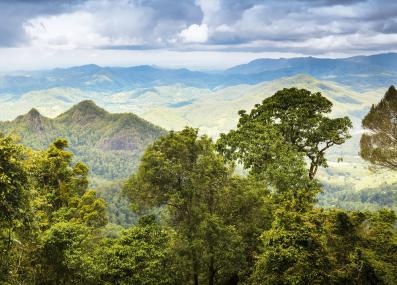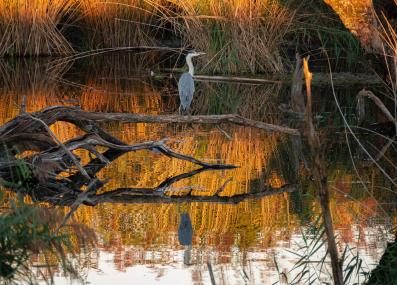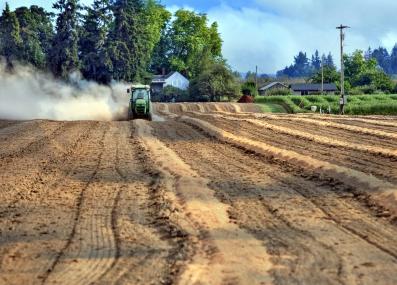Have a question?
How many new trees would we need to offset our carbon emissions?
Because of the complexity of the carbon cycle, the answer is not obvious. What is obvious, MIT experts say, is that we should not only plant more trees but also put much more effort into protecting existing forests.
Updated January 5, 2024
As trees grow, they take in carbon from the air and store it in wood, plant matter, and in the soil, making them what scientists call “carbon sinks.” In this way, forests play an important role in the global carbon cycle by soaking up lots of carbon dioxide (CO2) that would otherwise live in the atmosphere. Could we plant enough trees to absorb the amount of CO2 that Americans create and, in theory, cancel out our planet-warming carbon emissions?
It’s tempting to think that a back-of-the-envelope calculation can deliver a useful answer. For example, in 2021, the U.S. emitted about 5.6 billion tons of CO2 and other greenhouse gases.1 A hectare of trees, meanwhile, might hold around 50 tons of carbon, equivalent to around 180 tons of CO2 in the atmosphere. At this rate, it would take a little over 30 million hectares of trees to account for one year of American emissions—or a forest roughly the size of New Mexico. (For context, the United Nations estimates that there are about 4 billion hectares of forest on Earth right now.2)
So that’s the answer, right?
Well, no. In reality, the carbon math is much messier. For one thing, the type and age of the trees matters enormously. Studies of different forests have found that some store not much more than 10 tons of carbon per hectare, while others store well over 1,000.3 Our rough estimate of 50 tons per hectare would not be uncommon for a young-ish forest in North America, according to figures from the U.S. Forest Service, but the details matter.4
More importantly, trees aren’t simply vacuuming CO2 out of the air and making it magically disappear. “The solid material in the tree is organic carbon, and that's all carbon that is pulled out of the air,” says Charles Harvey, a professor of civil and environmental engineering at MIT who studies carbon storage in forests. “So gaseous carbon dioxide in the air is turned into wood and roots and leaves, through the process of photosynthesis.”
And that means forests take in the most carbon when they’re full of young trees that are still growing. “A mature forest has reached an equilibrium, where trees are dying and being replaced at basically the same rate,” says Harvey—so carbon exits these older forests about as quickly as it comes in. This is why we can’t simply count the over 300 million hectares of forest already in the U.S. against our carbon emissions.2 These established forests are doing some work to pull CO2 out of the atmosphere, but they are not an infinite carbon sink.
There are practical problems, too. One key question, says Harvey, is how much treeless land is available for planting? Dense forests once covered the American Midwest, for example. They could grow there again, but much of that treeless land is now used for cities, agriculture, and industry. If you imagine planting a forest the size of New Mexico every year to cancel out our emissions, you’ll quickly see the scale of this challenge.
There’s another problem, too: trees don’t last forever. When they die and decay, burn in a wildfire, or are chopped down and burned for fuel, trees release all the CO2 they’ve been hiding away. This means that each time we “reverse” some of our emissions with a new forest, we have to protect that forest permanently.
Finally, says Harvey, humanity’s emissions have begun to tip the natural carbon cycle out of balance. For now, this is probably helping trees remove CO2: with more CO2 in the atmosphere, there’s evidence that plants have started to absorb it faster. But the enormous complexity of this cycle makes it harder than ever to predict how forests will take in carbon in the future. Trees need not only carbon dioxide but also nutrients from the soil like nitrogen and phosphorus to grow. Research by César Terrer, MIT assistant professor of civil and environmental engineering, has shown that trees will need much more of both nutrients to balance their diets as the CO2 concentration in the atmosphere increases. If the soil does not have enough, that could curtail how much new CO2 a tree is able to store.
For all these reasons, Harvey says, society could get more bang for its buck by focusing on preserving existing forests, rather than prioritizing new growth to offset emissions.
“Planting trees where they've been lost is often a good idea, and that will take up CO2,” Harvey says. “But a much more efficient thing to do, to have a larger effect for the same effort, is to stop cutting down trees. It's almost silly to think about planting a huge number of new trees while we're just burning and destroying them everywhere, releasing carbon at rates that are much higher than what new growth would take up.”
Thank you to Robert August Dow of Columbus, Georgia, for the question. You can submit your own question to Ask MIT Climate here.
1 U.S. Environmental Protection Agency: Inventory of U.S. Greenhouse Gas Emissions and Sinks: 1990-2021. April 13, 2023.
2 Food and Agriculture Organization of the United Nations: Global Forest Resource Assessment 2020.
3 See for instance: Ganamé, Moussa, et al., “Aboveground biomass allocation, additive biomass and carbon sequestration models for Pterocarpus erinaceus Poir. in Burkina Faso.” Cell, Volume 6, Issue 4, April 2020, doi: 10.1016/j.heliyon.2020.e03805; Schafer, Luke, Marin Lysák, and Christian B. Henriksen, “Tree layer carbon stock quantification in a temperate food forest: A peri-urban polyculture case study.” Urban Forestry & Urban Greening, Volume 45, 2019, doi:10.1016/j.ufug.2019.126466; Dhyani, Shalini, et al., “Quantifying tree carbon stock in historically conserved Seminary Hills urban forest of Nagpur, India.” Acta Ecologica Sinica, Volume 41, Issue 3, 2021, doi:10.1016/j.chnaes.2021.01.006; Sahoo, Uttam Kumar, et al., “Quantifying Tree Diversity, Carbon Stocks, and Sequestration Potential for Diverse Land Uses in Northeast India.” Frontiers in Environmental Science, Volume 9, 2021, doi:10.3389/fenvs.2021.724950; Kauffman, JB, and RK Bhomia, “Ecosystem carbon stocks of mangroves across broad environmental gradients in West-Central Africa: Global and regional comparisons.” PLoS ONE, Volume 12, Issue 11, November 2017, doi:10.1371/journal.pone.0187749
4 Hoover, Coeli M., Ben Bagdon, and Aaron Gagnon, “Standard estimates of forest ecosystem carbon for forest types of the United States.” U.S. Department of Agriculture, Forest Service, Northern Research Station, 2021, doi:10.2737/NRS-GTR-202








